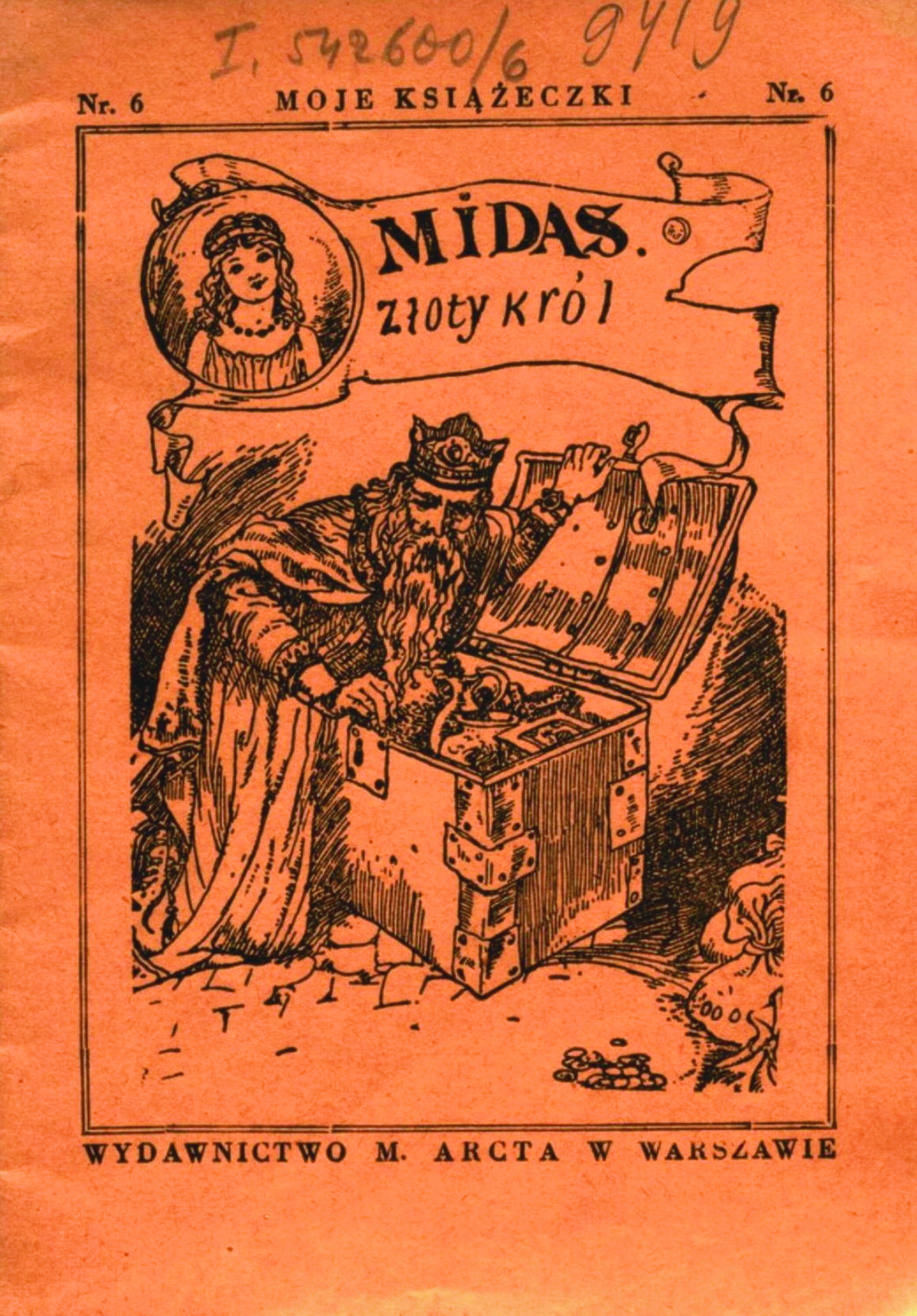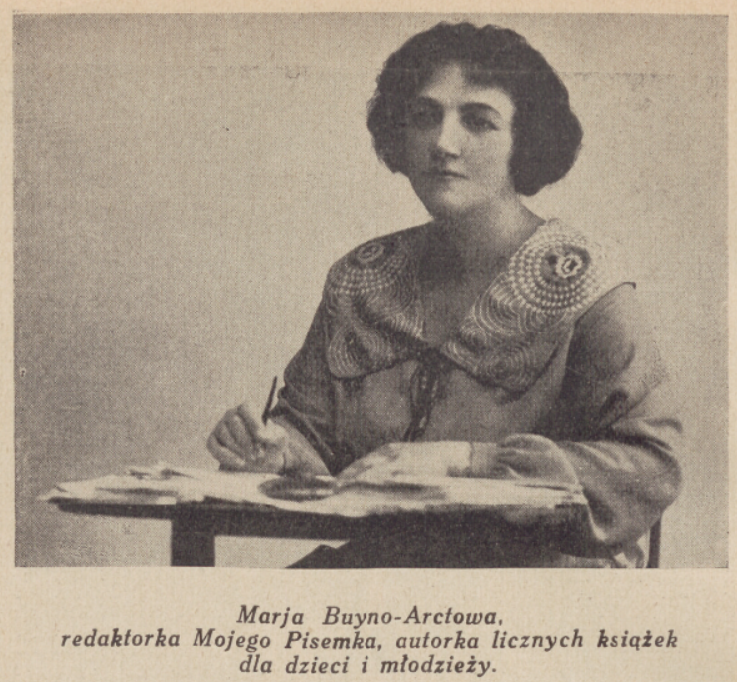Title of the work
Country of the First Edition
Country/countries of popularity
Original Language
First Edition Date
First Edition Details
Jagmin, Midas. Złoty król [Midas. A Golden King], "Moje Książeczki" 6. Warszawa: Wydawnictwo M. Arcta, 1931, 17 pp.
ISBN
Genre
Adaptations
Myths
Target Audience
Children (5–15)
Cover

The publisher of the text closed down in 1953 leaving no known successors, and we were unable to determine if there are any copyright holders. Including the cover in our database meets all fair use requirements, still, we invite the users to share with us any information they may have about copyrights to the posted materials.
Author of the Entry:
Summary, analysis: Adam Ciołek, University of Warsaw, adamciolek@student.uw.edu.pl
Analysis: Hanna Paulouskaya, University of Warsaw, hannapa@al.uw.edu.pl
Peer-reviewer of the Entry:
Elżbieta Olechowska, University of Warsaw, elzbieta.olechowska@gmail.com
Katarzyna Marciniak, University of Warsaw, kamar@al.uw.edu.pl

Maria Buyno-Arctowa, circa 1929, in Michał Arct, Jak powstaje książka, Warszawa: M. Arct, 1929, 66. Public domain. Source: Polona (accessed: August 1, 2022).
Maria Buyno-Arctowa
[Jagmin, Ciocia Mania, J. Brzostek] , 1877 - 1952
(Author)
Author of more than 80 books for children and young readers, e.g. Kocia mama i jej przygody [Cat Lover and Her Adventures], 1905; Słoneczko [The Little Sun], 1920; Dziecko morza [Child of the Sea], 1937; especially popular in the period between WW1 and WW2. She married into a family of publishers specializing in children’s literature; she worked at her husband’s publishing house as director of the children’s section. From 1902 to 1936, she contributed to the children’s magazine “Moje pisemko” as editor-in-chief and author using various pseudonyms, e.g., Jagmin, Ciocia Mania, J. Brzostek.
Sources:
“Arctowie”, in Julian Krzyżanowski and Czesław Hernas, eds., Literatura polska. Przewodnik encyklopedyczny, vol. 1: A–M, Warszawa: Państwowe Wydawnictwo Naukowe, 1984, 29.
“Buyno-Arctowa Maria,” in Julian Krzyżanowski and Czesław Hernas, eds., Literatura polska. Przewodnik encyklopedyczny, vol. 1: A–M, Warszawa: Państwowe Wydawnictwo Naukowe, 1984, 124.
Szałagan, Alicja, “Buyno-Arctowa Maria,” in Jadwiga Czachowska and Alicja Szałagan, eds., Współcześni polscy pisarze i badacze literatury. Słownik biobibliograficzny, vol. 1: A–B, Warszawa: Wydawnictwa Szkolne i Pedagogiczne, 1994, 361–364.
Bio prepared by Adam Ciołek, University of Warsaw, adamciolek@student.uw.edu.pl
Summary
Based on: Katarzyna Marciniak, Elżbieta Olechowska, Joanna Kłos, Michał Kucharski (eds.), Polish Literature for Children & Young Adults Inspired by Classical Antiquity: A Catalogue, Faculty of “Artes Liberales”, Warsaw: University of Warsaw, 2013, 444 pp.
King Midas loves only two things: gold and his daughter, Złotuszka [Goldie]. He collects as much gold as he can for his daughter. One day while counting the money in the treasury, Midas meets a young man who offers to fulfil one of his wishes. Midas wishes that everything he touches transforms into gold. The following day, the king wakes up and realizes that his wish was granted. He changes many objects into gold but also experiences some problems: his glasses turn into gold, as does a handkerchief made for him by his daughter; despite these unexpected difficulties, he remains happy. However, his happiness ends when Midas realizes that he cannot eat or drink because food also turns into gold. In despair, the king, forgetting about his “gift,” kisses his beloved daughter, and she becomes a golden statue. Then, the young man reappears and, after a short dialogue during which Midas is brought to realize the consequences of his greed, the man tells Midas to bathe in the river – its waters will remove the “gift.”
Analysis
The author uses the name of a mythical character and the theme of a mythical story, but there is no direct reference to Antiquity (the story happens in a rather vague fairy-tale setting; lifestyle and conditions seem closer to modern times, e.g., Midas wears glasses). Myth is used to demonstrate the consequences of greed. There is no mention of Dionysus; the miraculous power is granted by a “young man” who appears out of nowhere and first fulfils Midas’ wish and then tells him how to get rid of it by washing in a nearby (sic!) river and splashing all the changed objects with water from that river (pp. 14–16; cf. Ovid, Met. 11.136–141).
Like in Nathaniel Hawthorne’s version of the myth in A Wonder Book for Boys and Girls (1851)*, king Midas has a daughter whom he loves the most, and she is the main reason for his changing his mind. Even her name, Złotuszka [Goldie], while it is made up and is not a real name, it is a similar play on words to Marygold, the name the American writer gave to Midas’ daughter. Another important motif is the inability to eat or drink, and Midas openly admits that a piece of black bread and a cup of clean water are worth more to him than all the gold in the world (pp. 10–14).
The story contains a straightforward moral lesson and is addressed to a young audience as a parable emphasizing values and the need to be careful what we wish for. There are also some humorous elements, for example, the scene when “the princess sees herself all splashed with water by her father who is also dripping with rivulets of water!” [Jakże zabawną minkę miała królewna, kiedy, ożywszy, zobaczyła się zlaną wodą przez ojca, również ociekającego strugami wody!] (p. 16). The story also contains references to the modern world, such as “today’s aircraft or electric tram” ([dzisiejszy samolot lub tramwaj elektryczny], p. 3) compared to miracles in the times of Midas.
* For more on the reception of Midas’ myth in children’s literature see Elizabeth Hale and Miriam Riverlea, Classical Mythology and Children’s Literature: An Alphabetical Odyssey, Warsaw: University of Warsaw Press, 2022, 58–60.
Further Reading
Elizabeth Hale and Miriam Riverlea, Classical Mythology and Children’s Literature: An Alphabetical Odyssey, Warsaw: University of Warsaw Press, 2022.
Roberts, Deborah H. and Sheila Murnaghan, ”’A Kind of Minotaur’: Literal and Spiritual Monstrosity in the Works of Nathaniel Hawthorne” in Katarzyna Marciniak, ed., Chasing Mythical Beasts. The Reception of Ancient Monsters in Children’s and Young Adults’ Culture, Heidelberg: Universitätsverlag Winter, 2020, 55–74.
Skrzypczak Andrzej, "Księgarnia i wydawnictwo Michala Arcta w Warszawie 1887–1950", in Justyna Myszkowska, ed., Warszawscy wydawcy, Warszawa: BPW. BGWM, 2003.


